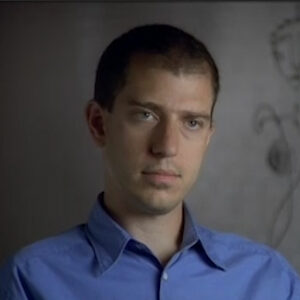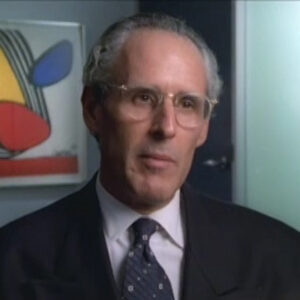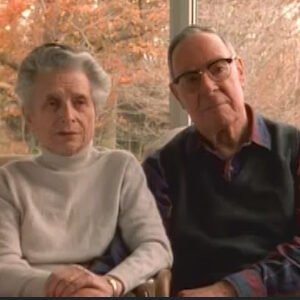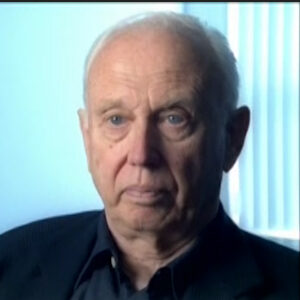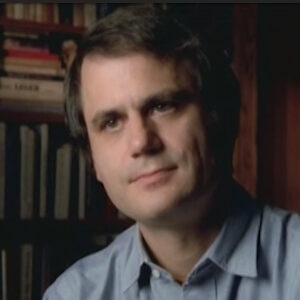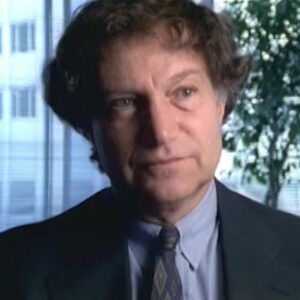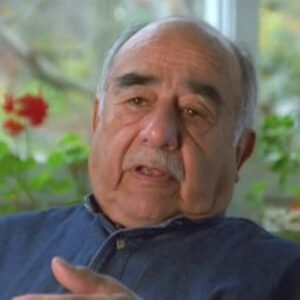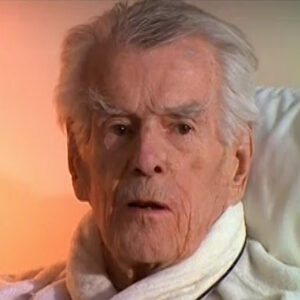Interviewer: Take yourself back. When did you first become aware of the art of Calder and what did you think when you first saw it?
Giovanni Carandente When I was the young in assistant director of the National Gallery of Modern Art in Rome and a few years later in 56, I met him personally because he came to Rome with his wife, Luisa. And it was an exhibition of him. The first one down in Rome at the Obi Lisco Gallery. And it was wonderful meeting to stay with him, to spend time with him, to become a friend of him, to become a close friend of him, because I must say now. It’s half of my life has been spent with Luisa and Alexander Calder.
Interviewer: Let’s cut for a second. Are you hearing the camera? Why, if you could you mention the names, Spoleto, why Spoleto? How did how did Tilapia IPO happen?
Giovanni Carandente In nineteen hundred sixty one, I was invited by the Museum of Modern Art of New York to do something for the Festival of Spoleto and I did an exhibition of a modern American drawing’s. At the end of the success of this exhibition, Menotti asked me to do something for the next year. Sixty two. And I had the brilliant idea. I must see sculptures in the city. I wanted to put in all over the town, the ancient town, of Spoleto sculptures by contemporary artists. And one of my first idea was to ask Calder to make a big stabile. As the entrance to the exhibition, the entrance to the town. At the beginning. He asked, he had the idea to make a mobile. With the summer car bustle and after with. Aye, aye, aye, aye part. Mobile on the top. And after a few months, he changed the idea and he sent me a letter with his more drawing, which is now in the museum in Spoleto. Instead of a mobile l am making for you a stabile. And this was the Maquette to the Lapua. The maquette was realized in a steel fabric in north Italy. And when it was put together, all the pieces were sold together. We’ve found that it was necessary to make some reinforcements. James Johnson Sweeney came. And so I told him it is a problem I had and Sweeney and me, we sent a telegram to Calder. And he immediately answered. I loved Danja. I’m coming and he came. So they are the Lapua was reinforced. And to the appeal was the first stabile made by Alexander Calder in the world of that size, the size of the a monumental piece, a city, a European sculpture.
Interviewer: I understand that he had wanted to make bigger pieces for many, many years. Could you tell us about that that he had made? Tell us about that. Make it big, maquettes and trying to get people, but no interest. Yeah.
Giovanni Carandente Yeah, well, but he had done a medium size pieces, not enormous like this. When he came to Spoleto to see the the the the big stabile realized that he sent me a kind of a of a declaration. He said I first quote side. The size of the sculpture from the train and it looked to me. Why do I care then, wider? I imagine that she should be wider and she was higher. So I am very pleased with it. And this was the beginning of a long series, stabiles. Afterwards, he made stabiles during his life. For all the most important cities of the world, from Australia to America, from Europe to Canada. So now there is a a an important patrimony of modern sculptures done by Calder.
Interviewer: Let’s talk about some big issues of Calder. In your writings you speak of the naturalness of Calder sculpture. But let’s cut. We have sirens. Tell me about Calder’s way.
Giovanni Carandente Of making works of art?
Interviewer: This naturalness. If you could say the word again.
Giovanni Carandente Well, the naturalness of Calder is implicit in his art because he started representing animals in movement, human being in movements, acrobats, dancers, circus people. And after he became abstract when he saw Mondrian and the E transformed the ease. Is vocabulary in into an abstract vocabulary that is still natural when he does a mobiles or stabiles. In 67 the director of the Opera Theatre of Rome asked through me Calder to make a performance. To make a decor for a ballet. But the director of the opera, intended to have a scenery. While Calder likes to do something different. A real spectacle. Of his art is a invention into a form, a theatrical form. This was a work in progress, which is one of the most important works of art of modern art in theater since the D.A. Times. Nothing else has been produced like the Work in Progress, which is a show exalting movement and also primordial forces of nature. Sun, Moon, the sea.
Interviewer: I’m sorry. We have to cut. Stop. We have the. Just start again from the description of what was there primordial pieces.
Giovanni Carandente Primordial or primorial.
Interviewer: Primodial. You were describing the that.
Giovanni Carandente You say primordial or primordia.
Interviewer: You said primordial?
Giovanni Carandente Yeah.
Interviewer: Would you just start again from there? Tell me what was in why was this work in progress so important?
Giovanni Carandente Because it these are the only spectacle of this kind made in the theater in the 20th century. Nobody else has been a soul genius. So inventive like Calder that a making a story with nothing. Then I’ll know a story that is there are no dancers on the scene. There are only forms in movement. And the forms naturally are primordial, like sun, moon, stars. Animals, flags, the waves of the sea, the fruits of the the trees, the spring, the winter, the elements of nature. This is naturalness of Calder.
Interviewer: I’m going to sort of jump around different things because there’s so much to cover. Do you think he owes anything to other movements of of modern art, cubism, constructivism? He joined abstract abstraccion creacion for a little while. Does he who were his influences, do you think?
Giovanni Carandente Um, I think he had the inferences, uh, from Monge especially but, I must tell you a story. Sorry.
Interviewer: Start again.
Giovanni Carandente There is a there are some sources of his art before all the Indian reservation art which he saw when he was a young man. And after he’s father and his grandfather after that when he arrived to Paris. He understood everything of the modernism. Montdrian was the cutting of his art in two sections. Before Mondrian and after Mondrian. The abstract. After the figurative. But the he was influenced by Matisse. Once he gave me a wash. Which as the square forms of different colors, you can see easier and I choose that in a couple of of gouaches which are wearing this gouache. And they ask of me, why you have chosen just this one doesn’t seem thrilled to match Matissean. And I said, well, it is Matissean in a sense, but this especially especially is Calder.
Interviewer: What did Calder say to you after you picked up after you chose that gouache?
Giovanni Carandente Why have you chosen this one? This is especially this one. And I said, because it is beautiful. Said, don’t you think this is a little bit Mattisean? I said yes, in a certain sense, remembers me some guts, cuts out cutouts of Mattise. But it’s beautiful. As I as far as I know, this is unique. That is not another one that’s similar.
Interviewer: Calder was did many firsts, and I don’t think people today know. Could you just lists the first things he really was innovative in? What did he innovate?
Speaker He innovators innovated, especially the inception of movement in contemporary art. This was after the 30s, before he was a wonderful designer, a wonderful grower, a wonderful painter, a wonderful sculptor. But no, not yet a revolutionary. He became a revolutionary and unique in the history of a sculpture of 20th century. After 30 after 1930, when he started to do the mobiles, the mobiles is the greatest invention of the him. Certainly stabiles are important, but the mobiles as John Paul Safra said the most of America and the most poetical invention in the contemporary sculpture. They ever the changing of a butterfly’s the movement of our book of Tree Leaves. These is naturalness.
Interviewer: Would you say he was the inventor of an art form, and if you agree. Could you say that?
Giovanni Carandente Yes, of course.
Interviewer: Would you say that?
Speaker He was an inventor of a new art form. Some American critics have spoken about the similarity with Miro art, especially because they were Constellation’s in the same period, in the same time made by Miro and made by Calder. That Miro was in Europe and Calder was in America at that moment. It was the war moment. And so nobody of them knew about the work of the other. And there is only a a if a very good friendship. I remember when it was an exhibition of Calder in Paris after it was a very, very big dinner at the Gala de Leo in the very pompous atmosphere of the gala Leo. Miro was with the with Calder together. They were like France, like brothers, not like friends. So there is a certain similarity between the art of one and the other, but no one of the two depends on the other.
Interviewer: You also, in your writing, talk about no other no sculpture has ever achieved the true conquest of sculpture and spontaneous movement. Could you describe that again to me, as if I hadn’t said that.
Giovanni Carandente The story of the movement meant in modern art goes back to the time of the constructivism, the Russian constructivism, and also to If you if we. Think to Garbo and personnel and also to other artists who make motorized movement in art. But Calder as invented the spontaneous movement. A mobile moves in a room only with the your breath already with your passing through in the room. This is the most spontaneous way of inventing the movement.
Interviewer: Fantastic. Thank you. Do you think he would have been the same artist if he had not gone to Paris?
Giovanni Carandente No. No. Eliseo has called him a merry can sample some American hundred surrounded. But it was really it became really a part of the vanguard, the vanguard of century living in Paris and becoming a also French. When I went to see him, it was a treat four times a year in sashay in train. He lived like the the the village people. In the morning he went out for a going to the Atalay up on the hill and he said, say hello to everybody in the streets like a a born in sachet. A a a French born. Louisa was a little a little more apart from this because she kept her a wonderful nature of intellectual. She was one of the most important ladies in the art world of this century.
Interviewer: Why? Stop a second. Cut, please? We have a battery. Could you again say Louisa was the most important woman in modern art and tell me why?
Giovanni Carandente Louisa was born James. She was the niece of the famous writer and also the niece of the famous pragmatist philosopher and I think she took the character of the two. Because she was a very strong lady. And also very, very weak. She never let people making compliments to her. She was very severe, very austere.
Interviewer: Sorry, cut. Would you just start again where you were saying that she wouldn’t let compliments be made.
Giovanni Carandente Louisa was very interested in social problems. Louisa was against the war in Vietnam. Louisa was the lady who continued to read all along in life and to work also. She did the Tapestries. She did carpets, she did also works done with the model designed by Sandy. I call them. But this especially, she was a wonderful lady of absolute everity. She never.I saw her very, very little time smiling or conceding to people. Not important things. She will unimportant things. She was really a lady who had a mission, who felt to have a mission in her life. And she absorbed that mission perfectly.
Interviewer: And what was the mission?
Giovanni Carandente The mission to help other people.
Interviewer: And how did she brings. Go ahead. Cut for a second. Tell me why the Calder circus was so wonderful, what was it?
Giovanni Carandente The circus now exists in the original in the Whitney Museum. And in the film that the Marquis beat out, they both did. But I was one of the spectators of the of the film of the spectacle.
Interviewer: Start again. I was one of them.
Giovanni Carandente I was one of the real assistance to the performance. It did for me sashay. One of the last in the 70s. In the 60s. One of the last after he gave the secrets to the Whitney Museum of American Art. And it was absolutely a amusement and an unbelievable amusement, but not an amusement in the sense of joke. How deep, how sensitive, how profound it was in respect of both the dancers, circus people and animals. If you have a seat in one of the performance now in the film, you can understand how we was interpretating himself, the performance and the Louisa was part an integral part of this spectacle because she gave props to Sandy, she moved the records in the in the machine. She was really an actor like Sandy.
Interviewer: Tell me whether you think the circus was an innovation or was it just child’s play?
Giovanni Carandente No is not a child’s play. No, it’s something more. More, much more. You can seen the film. I know that in France now they say they give the film in in the in the normal cinemas, in the in the normal rooms for cinemas for movie. And a friend of mine has a scene, one in that young. Calder not only for the exhibitions he had in Italy, but also for his pleasure, came many times in Italy and all the time I was his companion travelling in 66. It was the famous flood in Florence. I wanted to see the effect of the floods. And I remember we arrived. The mud was still in the streets of Florence. We arrived with the car at the entrance of the city and immediately said. Go to see the door. The door was The Golden Door by Lorenzo Ghiberti of the Baptistery of Florence Innu from the papers that they have been damaged, very much damaged from by the flat. And he wanted to to go the first to see that. And after we went to see the wonderful Chima boy cross completely damaged, almost destroyed. And we went to a small laboratory of graphic works and it was astonished to see in which terrible condition it was. And so immediately, if it did, they with a crayon, black and red it into a little graph, a little graphic crayon. It did the dictograph. And he said you can take it for to the owner of the laboratory to sell it for restoring your building. And after he wanted to go to the south of Italy. He want to go to Vitara Apulia in a pool here to see the family of one of these assistants in Roxbury, Connecticut. And it was a wonderful, wonderful trip. He wants to see the truly because somebody told him that the truly Naledi Lobello, where add on the top of some moving form, some mobiles, and he wanted to go there and see he was less interested in mundane places like Tower Me Now or the City’s More Coppery, etc. He wanted to go to Syracuse to see the inn and archeology and to Palermo to see the cathedral.
Interviewer: Can you talk about the progression of his art? You look at from one type of art wire sculpture, it seems like there’s a continuous line you can draw. Can you talk about that from your perspective?
Giovanni Carandente Yes. Well, the beginning of in the in the abstract period, they say after 30, the beginning is in the drawings, the drawings, the linear drawings he did are the place where you were born and the Mobiles . After that at the mobiles, after the mobiles with an interruption in 44 during the war, because it was not easy to find aluminium and iron. Indeed, the bronze is the plaster’s of the expressionistic bronze is moving in in several parts and. It continued with with the wonderful Constellation’s when towers.
Interviewer: What did you think of all this?
Giovanni Carandente Well, these are marvelous repertory of the forms. From the beginning, from the first Mobiles until the towers and constellations and after the E became to do small stabiles. Sometimes the small stabiles were the pedestal of a mobile. So they were standing mobiles and after sixty two after today, Lapeer, they started to be the the models, the maquette for an enormous and monumental pieces of art at the European scale.
Interviewer: How much footage left? 60 meters. People today, I think, only know Calder from the mobile in the stabile. And so while people say, I know Calder, I’m not so sure. Could I ask you to start a sentence? Repeat a sentence and then continue a sentence? People think they know Caulder and then continue.
Giovanni Carandente No, no capito
Interviewer: Let’s let’s cut for a second and I’ll explain.
Giovanni Carandente The art of Calder is almost known in the world. Now, maybe it is called. It is known only for some pieces like the monumental stabiles or the mobiles in the museums. I believe that the interpretation of Calder is maybe wrong sometimes because they are interpreted him as a maker of joke. And he’s not a maker of joke. He has been one of the greatest sculptors of the century, together with David’s meet in America, together with other sculptors in Europe, like Moore, like Merino Moreni, etc., but his art is important in his time because he has been the inventor of the new free form of art
Interviewer: How do you think he should be remembered?
Giovanni Carandente As the inventor of the movement in art.
Interviewer: Do you miss him?
Giovanni Carandente Oh A lot.
Interviewer: Tell me.
Giovanni Carandente Alot. A lot. Yes. As you can see, I live with him in my house because there are portraits by him. J.
Speaker Okes, buy him pieces of paper made by him. So I continue to live with him.
Interviewer: Tell me about his joking, about his love of puns. Tell me about the man. What should we know about Calder, the man?
Giovanni Carandente Well, it was a wonderful man, but not in the sense of joke. It was a wonderful man in the sense of humanity. It was the greatest humanist of the century.
Interviewer: Why?
Giovanni Carandente Because of what he has done as is human. It’s so simple. Like the Florentine artists of the 15th century. He is always human. Like Piero della Francesca, like Botticelli, like Leonardo. He was an inventor, but he was also explaining his invention in the human way of life.
Interviewer: Wonderful. Thank you. Let’s cut. I think we’re I think we’re done.
Giovanni Carandente The importance of Calder after.
Interviewer: I’m sorry. Speak to me.
Giovanni Carandente The importance of Calder after the 20s is also to have put the American art out from the provincial academic center in which it was closed because he has brought to the esprit de finace of Europe into American art.
Interviewer: Fantastic. Let me go back to the talking. No, you just answered that cut again. Cut please. He seems like a man without doubts.
Giovanni Carandente No. He had doubts. He had doubts in his life. And once in from the steel market, it was presented with two similar objects. One was the original made by him. The other was a fake and he asked me don’t you think that this is a very easy. Isaid, what? To make a copy of my work. I said no Sandy, it is impossible because when it is an original it has balance, when it is not original, cannot have balance.
Interviewer: And what did he think of that?
Giovanni Carandente He had the doubt and he said don’t you think he’s very easy to copy me? This was his doubt. That his art was a simple and easy to be made. Absolutely not like this.
Interviewer: Thank you, sir, very, very much. Let’s cut. Thank you.


